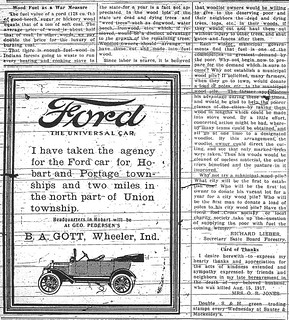 (Click on image to enlarge)
(Click on image to enlarge)
Outlined in red is the John Wojahn farm, where his son Louis farmed; outlined in orange is the extensive Bragington farm, part or all of which was rented and farmed by Ed Maybaum.
Late in the summer of 1917, two long-time Ainsworth farmers separately announced their intention to get out of farming and Ainsworth.
If we can believe the
News, the Wojahn family bought their 92 acres on the south side of the Lincoln Highway around 1882, when Louis was born.
Louis' parents, John and Minnie Wojahn, had both immigrated from Germany (1871 for John, unknown date for Minnie). Ross Township was crawling with Wojahns, but since I haven't figured out their family relationships yet — I suppose I have to wait for the right obituary — I won't go into that now.
At the age of 20, Louis went to work on the William Sykes farm in northern Ross Township. After about a year of that, he came back home to rent the old place from his parents and farm it for himself.
On May 10, 1903, Louis married Lena (Carolina) Fasel, eldest daughter of Henry and Mary Fasel, who farmed south of Hobart. The young couple lived and worked on the Wojahn farm. (About a year later his parents moved to Chicago to stay with another son, but they eventually came back to Ainsworth.) In 1905 Louis expanded his operations by renting additional farm land near Wheeler. The little household had increased by one: in 1904 the Wojahns took in an 11-year-old orphan boy named Charlie Wishon. He stayed with them for six years, then abruptly ran away.
Louis and Lena had three children — Irwin (born 1908), Emily (1910) and Lucile (1914). In 1910 the Wojahns bought Dr. L.M. Friedrich's brick house in Hobart and moved it onto a lot on Lake Street south of the "J" tracks, to rent out for additional income. By 1911 they had a telephone and an automobile. Life seems to have gone along peacefully for them, aside from the occasional
tree thief and
uninvited visitor.
Then in July 1917, Louis placed an ad in the
News: "For Rent — 92-acre farm, one mile southeast of Ainsworth on Lincoln highway. Louis Wojahn, Phone 1626-J-2." From the description, it could only be the old homestead. A week later the
Gazette explained that the Wojahns were planning to retire from their farm. Lena's parents had given them a 15-acre parcel southeast of Hobart (I believe it was on the south side of 10th Street, east of Hobart Road) where they were now building a six-room bungalow, their new home.
By mid-September, the Wojahns had found for the old farm a new tenant, who was to take possession on November 1. All that remained to do was to sell off the livestock and farming equipment they would not need on their new 15 acres. They hired an auctioneer and ran this advertisement for the October 2 auction:
 (Click on image to enlarge)
(Click on image to enlarge)
I find ads like this interesting for the information they give about what livestock and equipment made up a farm in that era. (For those who may be wondering — as I was until I looked it up — a cow is said to be "fresh" when she has newly come into milking condition, e.g., after having delivered a calf).
Just below this ad in the
News of September 17, a similar ad appeared for the other long-time Ainsworth-area farming who was about to cut and run — Ed Maybaum.
(To be continued)
Sources:
♦ 1874 Plat Book.
♦ 1891 Plat Book.
♦ 1900 Census.
♦ 1910 Census.
♦ 1920 Census.
♦ 1926 Plat Book.
♦ 1930 Census.
♦ 1939 Plat Book.
♦ "Ainsworth Pick-Ups." Hobart Gazette 30 Sept. 1904; 5 Aug. 1910; 2 Sept. 1910.
♦ "General News Items." Hobart Gazette 28 Mar. 1902; 29 Sept. 1905.
♦ "General News." Hobart Gazette 20 July 1917.
♦ "Local and Personal." Hobart News 23 Aug. 1917.
♦ "Local Drifts." Hobart Gazette 9 Jan. 1903; 29 July 1910; 5 May 1911; 24 Nov. 1911.
♦ "Personal and Local Mention." Hobart News 29 Oct. 1914.
♦ "Personal Mention." Hobart News 11 May 1911.
♦ "Public Sale." Hobart News 27 Sept. 1917.
♦ Untitled social column. Hobart News 12 July 1917; 20 Sept. 1917.
♦ "Wojahn-Fasal Nuptial." Hobart Gazette 15 May 1903.



















































